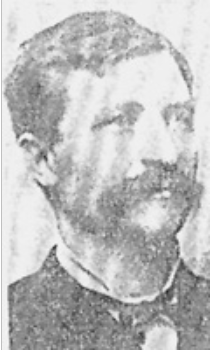Anderson, Andrew G.
Andrew G. Anderson was born in Sweden in 1854. At the age of 19, he immigrated to the United States and arrived in Sioux City. He was hired to work in a government warehouse even though he could not speak English. He soon got a job working on a ferry that carried people across the Missouri River to Nebraska. During this time, it is said that he rescued several people from the waters of the Missouri River.
In 1876, at the age of 22, he served on the first steamship to make the trip up the Yellowstone River in Montana. He returned to Sioux City, and three years later married Margaret DeSmet. They lived in the Prospect Hill area and had three children, two girls and one boy. Their children all died within three weeks of each other during the diphtheria epidemic.
The Andersons moved to the Springdale area and had three more children. Andrew was a hard worker and very thrifty person. He purchased several pieces of property including two houses and two store buildings. He got a job as a stationary engineer at the Green brickyards in Springdale. While he was an experienced riverman, he would never swim in the Floyd River because of the swiftness of its current.
On May 18, 1892, one of the greatest disasters in the city's history struck. A wall of water swept through the Floyd River, destroying everything in its path. The hardest hit were the Leeds and Springdale areas of town directly bordering the river. With little or no warning, the Floyd River Flood of 1892 struck with savage fury. Many climbed to the roofs of their houses to escape the torrent. Anderson, thirty-eight years old at the time, is credited with saving 27 people from the swirling waters before he drowned.
Three times during the day his friends forced him to leave his boat because of the great danger. Three times he fought to go out again. "How can anyone rest when people are drowning" he asked. While trying to rescue the Frank T. Henderson family, the husband, wife and infant daughter, Andrew died when his boat was struck by a log. The family had been trapped in their attic and after three attempts, Anderson had been able to reach their house and break a hole in the roof for them to escape. He was able to get them in his boat in spite of the six foot waves ripping through the area. When the boat capsized, Henderson tried to hold his wife and daughter. A log rolled over the family and all three were drowned.
Hundred of people attended Anderson's funeral at Trinity Lutheran Church. He was buried in Logan Park Cemetery, which is located on the way to Stone State Park. Sixteen years later a monument in his honor was placed in the cemetery by the Knight of Pythias lodge. The monument was made of granite mined in Sweden, approximately forty miles from the town where he was born.
In 1921, through the efforts of August Williges, a park was established in his memory. While there were many discussions as to placing a plaque or monument, nothing was ever done. By the 1950s the park had fallen into disrepair.
Anderson’s grave at Logan Park Cemetery


